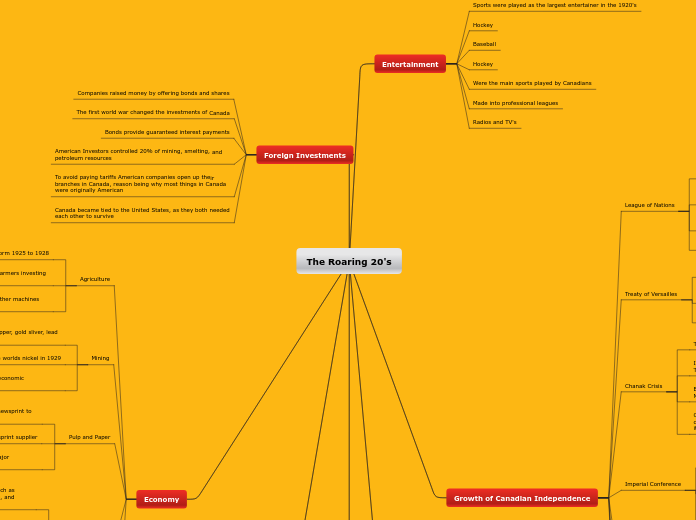The Roaring 20's
Entertainment
Sports were played as the largest entertainer in the 1920's
Hockey
Baseball
Hockey
Were the main sports played by Canadians
Made into professional leagues
Radios and TV's
Growth of Canadian Independence
League of Nations
It is an international organization, in Germany focused on peace
Created after World War 1 to provide a forum for resolving international problems
Britain and France joined, but not for the treaty itself, for the publicity and support as countries
For smaller countries this was a great oppertunity
Treaty of Versailles
It was a peace document that ended World War 1
Was one of the most important treaty, as it ended one of the largest wars in history.
Once Canada signed, they received some land and money
Chanak Crisis
This was a war scare
In 1922 in Balkans, a place was called Chanak located in Turkey
Britain had troops protecting the strait linking to the Mediterranean to the Black Sea
Canada refused to send troops to amidst Britain without confirmation and approval from its parliament when showed its increased independence from Britain
Imperial Conference
It was the 7th imperial conference bringing the P.M's of the Dominions of the British Empire
Imperial conferences were periodic gatherings of government leaders from self governing colonies
Mackenzie King was determined to resist any British efforts to establish a foreign policy for all dominions of Britain
Halibut Treaty
It was a Canadian-American agreement of fishing rights in the pacific ocean.
The treaty was established by the Internation Pacific Halibut Commission
It was meant as a mechanism for management of the Pacific Halibut
It was the first treaty made by Canada independently
King-Byng Crisis
It was a Canadian constitutional crisis
When governor general of Canada, Lord Byng of Vimy denied a request by P.M. William Mackenzie
First time the governor general refuses a P.M's request
Balfour Report
This report decleares Britain and it's Dominions were constitutionally equal to each other
This report was issued in 1926, and stated that Canada was an independent country
Statute of Westminster
Its an act of the UK parliament
Its editied versions are now a domestic law in Canada and New Zealand
It is a law that allwed the dominions of Britain to be unaffected by any laws that Britain makes
Lifestyle and Fashion
Fashion
Men wore flappers, formal morning suits with cutaway coats, striped pants, cravat, and vests as well, almost on an everyday basis.
Men never left their homes without their hats, and just like women wore them everywhere, although they took them off indoors. The Derby was the most popular hat of them all.
Women wore trousers, skirts, simple cotton dress, thick black cotton stockings, and low heel oxfords. Dresses were colorful plaids, checks, stripes, or solid colors with pretty embroidery and trim such as lace or rick rack. Housedresses often had white collars
Women never left their homes without hats and the most common one they wore was the Cloche.
Lifestyle
Women lifestyles drastically changed in the 1920's. They
Immigration and Racism
Foreign Investments
Companies raised money by offering bonds and shares
The first world war changed the investments of Canada
Bonds provide guaranteed interest payments
American Investors controlled 20% of mining, smelting, and petroleum resources
To avoid paying tariffs American companies open up their branches in Canada, reason being why most things in Canada were originally American
Canada became tied to the United States, as they both needed each other to survive
Economy
Agriculture
Praires enjoyed the wheat crops they got form 1925 to 1928
Agricultural prices climbed higher leading to farmers investing their profits in buying trucks
Farmers invested in trucks, harvesters, and other machines that would ease their business
Mining
The Canadian Shield deposited nickle, copper, gold sliver, lead and zinc in large quantities
Sudbury produced 80% of the worlds nickel in 1929
Canada's mining industry created many economic opportunities for Canada
Pulp and Paper
Canada's second largest industry was supplying newsprint to the United States
Canada was the worlds largest newsprint supplier
Quebec, Ontario, and British Columbia are the major producers of pulp and paper
Consumer Goods
There were new consumer goods to choose from such as electric stoves, refrigerators, vacuum cleaners, cars, and radios
These new consumer goods made the Canadian economy boom, because people were excited for these inventions leading to a bunch of people purchasing them
General Electric, Kodak, Hoover, and Westinghouse are examples of manufacturing companies
Examples of large chainstores are Lob-laws, Dominion, and Woolworths, selling groceries, clothes, and phonographs
Automobile
The automobile had a revoltionary effect on society as it changed their lifestyles
Going on trips (picnics, visiting relatives) was made much easier as you did not need to use horse carriages or walk there
It enabled farmers to come to town and sell their goods
In 1920, 1 in every 20 Canadians owned a car
Cars made the economy boom, because their costs were in the 1000's and that made the manufacturers a lot of money
The Automobile added more than $300 million to the Canadian economy in 1929
Inventions
Radio/Television
Provided entertainment to people
Automobile
Allowed pepple to travel with ease
Cotton Swabs
Made to clean up cuts faster
Traffic Lights
Made to stop traffic accidents and makes people go in turns
Jukebox
Made to play music and provide entertainment
Telephones
Allowed people to communicate from far away
Insulin
Made for diabetic people, working to lower sugar levels in a type 1 diabetic person
AirPlanes for Travel
Meant for people to travel to countries with sailing there
Refrigerators
Meant to make food last longer and cool it
Bandaids
Meant to stop cuts from infection and replacing the cotton swab and tape
Pop up toaster
Bread is inserted and pops out after a timer
Recliner
Allows people to sit comfortably, but recline at the same time
Shavers
Allowed mainly men to shave facial hair, without the use of blades
Hair Dryers
Allowed people to dry their hair in a quick session
